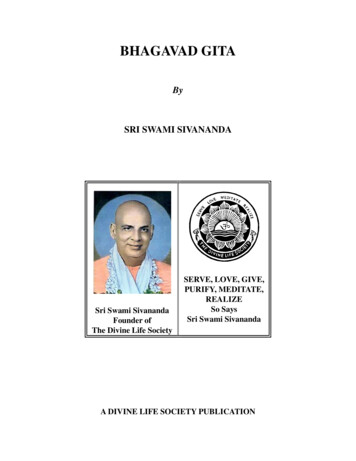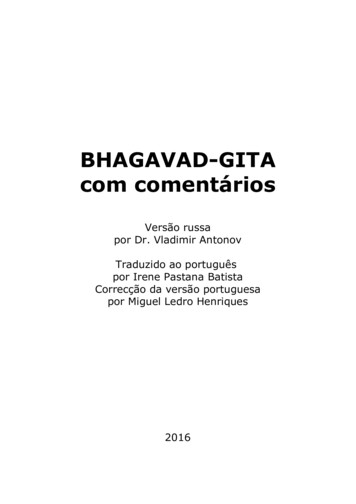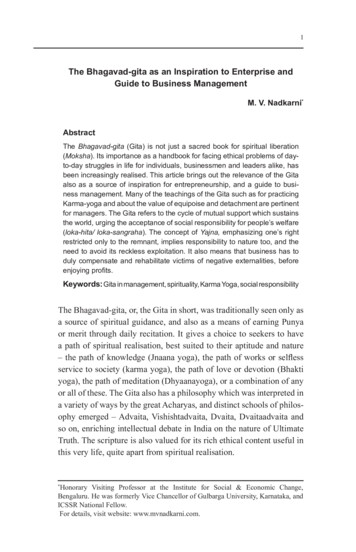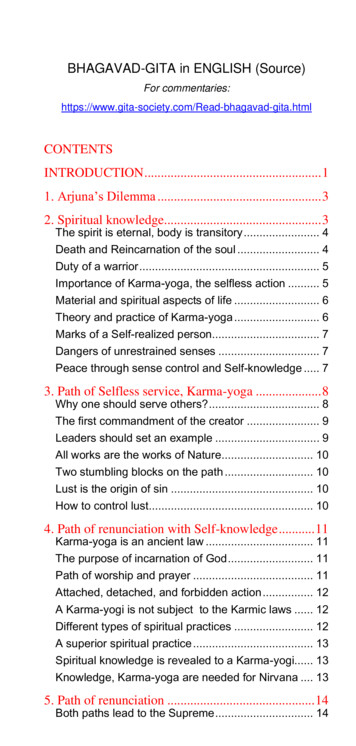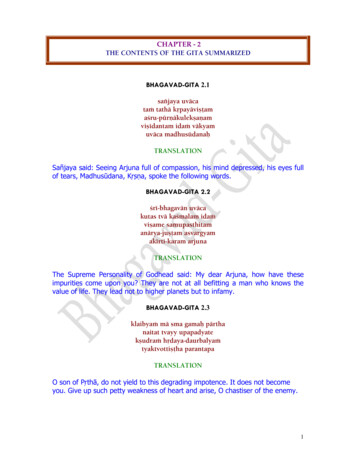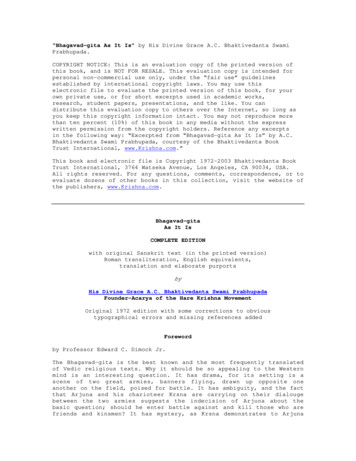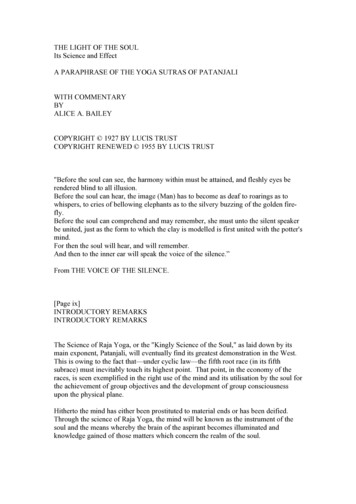
Transcription
THE BHAGAVAD-GITA(In Eglish and Hindi)For Children and BeginnersOur publications are available world wide from:Contact: sanjay@gita-society.comwww.createspace.com/ Gita for children (This book)www.createspace.com/3940466 Economy editionwww.createspace.com/ Gita in Englishwww.createspace.com/ Gita with Sanskrit verseswww.createspace.com/ Hindi Gita, this book(also available in India)INTERNATIONAL GITA SOCIETY, USA
iiInternational Gita Society
The Bhagavad-Gita for Children and BeginnersiiiTHE BHAGAVAD-GITAExcerpts from reviews“ Prasad’s deft renderings are elegantly simple, easy to understand and unencumbered bylong commentary. An ambitious work that will be appreciated by all who study the Gita . ”---- Hinduism Today, USA“ Explanations of the theory and philosophy of selfless service has been so beautifully expounded .”--- Prof. S. Tilak, Concordia University, Canada.“ More accurate than most other translations and rendered into modern prose, thismakes an excellent place to start with. "--- Gsibbery, Baton Rouge, LA.(in Amazon Book Review, 2005)“.It is marked by simplicity, terseness, and clarity and is devoid of superfluity. This book is refreshingly free from any sectarian slant. Any serious reader of the Gita would find this bookquite useful and rewarding .”--- Vedanta Kesari and Prabuddha Bharata, Magazines of Vedanta Society.“ I personally find many translations tedious because of complex structure. This translation issimply beautiful because it is beautifully simple ”--- Rev. Phil Buzzard, New York“. I am very interested in your translation of Gita. Though I have many English translations, Ithink your translation is the best one. So far, there are 5 versions in China, and I hope wecould translate your "Gita" into Chinese too. Could you grant the Chinese translation rights.”--- Dr. Zhicheng Wang, Prof. of Philosophy,Zhejiang University, Hangzhou (near Shanghai), P. R. China“ . I would like to include the translation of the Gita by Dr. Ramananda Prasad in my site. I aminterested in representing India fairly, and I fear that the translation of the Gita by Sir EdwinArnold that is distributed all over the net will do more to turn students away rather thanintroduce them fairly to the text .”--- Prof. Anthony Beavers, University of Evansville, Indiana.
ivInternational Gita SocietyAIMS AND OBJECTIVESofInternational Gita Society(Formerly: American Gita Society)Founded in 1984, the International Gita Society (IGS) is a registered, non-profit, tax-exempt,spiritual institution in the United States of America under Section 501(c) (3) of the IRS Code.Membership is free of charge and open to all. The Aims and Objectives of IGS include:1. Publish and distribute, The Bhagavad-Gita in simple and easy to understand languages, toanyone interested in the Gita.2. Spread the basic Non-sectarian Universal teachings of Shrimad Bhagavad-Gita and otherVedic scriptures in easy to understand languages by establishing branches of the Society inother countries.3. Provide support and guidance in establishing Gita Study and Discussion (Satsang) Groups,including a free Gita correspondence course.4. To provide inspiration, cooperation, and support to persons and non-profit organizationsengaged in the study and propagation of Vedic knowledge.5. To break the barriers between faiths, and establish unity of races, religions, castes, andcreeds through the immortal non-sectarian teachings of the Vedas, Upanishads, Gita,Ramayana, as well as other major world scriptures to promote the Universal Brotherhood.Readers interested in promoting the ideals of thesociety are invited to correspond with thesecretary: sanjay@gita-society.comThe International Gita Society511 Lowell PlaceFremont, CA 94536-1805 117, USAVisit us: www.gita-society.comwww.gita4free.comThis book is dedicated to all the children of the worldfor their spiritual welfare and learning of the Vedicwisdom as taught by Lord Krishna Himself.
THE BHAGAVAD-GITA(In Eglish and Hindi)For Children and BeginnersWith Introduction, A Lucid, SimpleEnglish and Hindi Renditions of over 200Simpler Gita Verses, Illustrated With 26Stories. Suitable For Children Grades8th and Above. A meditationtechnique and Simplemantras are alsoincluded.Ramananda Prasad, Ph.D.INTERNATIONAL GITA SOCIETY
viInternational Gita SocietySecond Children Edition, 2012Fifth (Paperback) Edition, 2012First e-book edition, 2012Fourth Edition, Second Printing, 2008First (Pocket Paperback) Edition, 2008First Children Edition, 2008Fourth Revised and Enlarged Edition, 2004First Hindi Edition, 2004(Published by Motilal Banarsidass in India)Free Pocket size editions, 2000-2012Third Revised Edition, 1999Third and other Printings, 1998Second Printing, 1997Second Revised and Enlarged Edition, 1996(Published by Motilal Banarsidass in India)First Edition, 1988Copyright 2000-2020 by theInternational Gita Society511 Lowell Place, Fremont, CA 94536Phone (510) 791 6953sanjay@gita-society.comVisit: ita4free.comAll rights reserved. This book, or parts thereof, maybe copied in any form only for non-commercialuse provided the credit is given to theInternational Gita Society.Other Editions (in USA):ISBN 0-962 1099-5-9 (Pocket Paperback)Buy from: http://www.lulu.com/content/3060287ISBN 0-962 1099-0-8 (Children Edition)Buy from: http://www.lulu.com/content/3062028Indian Editions:ISBN 81208 1390 1 (Asian Edition, English)ISBN 81208 2933 6 (Asian Edition, Hindi)Writer: Ramananda Prasad, Ph.D.Editor-in-Chief: Doret KollererHindi Translation: Ved Vatuk, D.Lit.Graphics and editing: Madhavacharya (Michael Beloved)Editorial Board:Sadhana Prasad, Kalavati Patel, Reeta Raina, Sanjay Prasad,Usha Gupta, Jay Raina, Raj Raina.A short note on pronunciation: “ā” is hard “a” sound as in Rāma.letter “a” in Sanskrit or Hindi words is soft “a” as in Albert. It isdifferent from “ā” sound and is either not pronounced or pronouncedvery very softly.
The Bhagavad-Gita for Children and BeginnersSTORYviiPageChap INTRODUCTION 11. ARJUNA’S CONFUSION .21. Mr. TRUTHFUL22. KNOWLEDGE OF GOD . 32. GRADUATION TEST53. PATH OF DUTY (KARMA-YOGA) . 63. SIR ALEXANDER FLEMING74. RENUNCIATION WITH KNOWLEDGE 104. EKALAVYA5. PATH OF RENUNCIATION .5. ADI GURU SHANKARACHARYA6. PATH OF MEDITATION .6. DHRUVA7. KNOWLEDGE AND ENLIGHTENMENT .1113141515167. SEE GOD IN ALL BEINGS188. THE UNSEEN188. THE ETERNAL BEING (BRAHMA) 199. THE STORY OF KING BHARATA9. KNOWLEDGE AND BIG MYSTERY .192110. A BOY WHO FED GOD2211. THE GREAT HIGHWAY ROBBER2312. THE FOOTPRINTS23
viiiInternational Gita SocietySTORY.10. MANIFESTATIONOF GOD .13. THE FOUR BLIND MEN11. VISION OF GOD .14. GOD IS WITH YOU12. PATH OF DEVOTION .15. BHAKTA PRAHLADA13. CREATION AND THE CREATOR Page2424252526272816. THE SALT DOLL2917. VEGETARIAN TIGER2914. THREE MODES (GUNAS) OF NATURE .18. THREE ROBBERS ON THE PATH303115. THE SUPREME PERSON 3119. A STORY OF BABY SHRIKRISHNA3220. THE STORY OF RAMAKRISHNA3316. DIVINE AND THE DEMONIC QUALITIES 3321. THE DOG AND THE BONE3422. THE STORY OF A QUEEN3417. THREEFOLD FAITH .3423. THE THIRSTY CROW3524. RABBIT AND THE TURTLE3525. A MAN WHO NEVER GAVE UP3618. NIRVĀNA BY GIVING UP EGO 26. I AM NO CRANE3738THE BHAGAVAD-GITA FOR CHILDREN IN HINDIEaImad\ Bagavad\gaIta³ikSaaoraoM AaOr AarimBak AQyaotaAaoM ko ilae 40
THE BHAGAVAD-GITA(For Children and Beginners)INTRODUCTIONJay: Grandma, I have a hard time understanding the teachings of the Bhagavad-Gita. Would you help me?Grandma: Of course, Jay, I will be glad to.You should know that this holy book teachesus how to live happily in the world. It is an ancient holy book of Hindu Dharma (also knownas Sanātana Dharma or Hinduism), but it canbe understood and followed by people of anyfaith. The Gita has eighteen (18) chapters anda total of only 700 verses. Anyone can behelped by daily practice of only a few of itsteachings.The word ‘Bhagavad’ means God orThe Supreme Lord, Bhagavān in Sanskrit.‘Gita’ means song. Thus The Bhagavad-Gitameans the Song of God or the Sacred Song,because it was sung by Bhagavān Shri Krishnahimself.Here is the introduction to the Gita:In ancient times there was a king whohad two sons, Dhritarāshtra and Pāndu. Theformer was born blind; therefore, Pāndu inherited the kingdom. Pāndu had five sons. Theywere called the Pāndavas. Dhritarāshtra hadone hundred sons. They were called the Kauravas. Duryodhana was the eldest of the Kauravas.After the death of king Pāndu, his eldest son, Yudhisthira, became the lawful King.Duryodhana was very jealous. He also wantedthe kingdom. The kingdom was divided intotwo halves between the Pāndavas and the Kauravas. Duryodhana was not satisfied with hisshare. He wanted the entire kingdom for himself. He tried several evil plots to kill the Pāndavas and take away their kingdom. Somehowhe took over the entire kingdom of the Pāndavas and refused to give it back without a war.All peace talks by Lord Krishna and othersfailed, so the big war of Mahābhārata couldnot be avoided.The Pāndavas didn’t want to fight, butthey had only two choices: fight for their rightbecause it was their duty or run away fromwar and accept defeat for the sake of peaceand nonviolence. Arjuna, one of the five Pāndava brothers, faced this choice in the battlefield.He had to choose between fighting thewar and killing his most revered guru, whowas on the other side; his very dear friends,close relatives, and many innocent warriors; orrunning away from the battlefield to be peaceful and nonviolent. The entire eighteen chapters of the Gita are the talk between confusedArjuna and his best friend, mentor and cousin,Lord Krishna an incarnation of God onthe battlefield of Kurukshetra near New Delhi,India, about 5,100 years ago. This conversation was reported to the blind king, Dhritarāshtra, by his charioteer, Sanjay. It is recorded inthe great epic, Mahābhārata.All lives, human or nonhuman, are sacred, and nonviolence or Ahimsā is one of themost basic principles of Hinduism. So whenLord Krishna advises Arjuna to get up andfight, this may confuse you about the principleof Ahimsā if you don’t keep in mind the background of the war of Mahābhārata.This spiritual talk between the SupremeLord, Krishna, and His devotee-friend, Arjuna,occurs not in a temple, a lonely forest, or on amountain top, but on a battlefield on the eve ofa war.Jay: This is an interesting story,Grandma. Can you tell me more?Grandma: If you come to where I sit everyevening, Jay, I will tell you the whole story,one chapter each day. Just make sure yourhomework is done and you have time to listen.If you agree, let’s start tomorrow.Jay: Thank you, Grandma. I’ll be thereto hear more.
2International Gita SocietyCHAPTER 1ARJUNA’S CONFUSIONJay: I would like to know first howLord Krishna and Arjuna happened totalk on the battlefield, Grandma.Grandma: It came about in this way, Jay.The war of Mahābhārata was about to beginafter peace talks by Lord Krishna and othersfailed to avoid the war. When the soldierswere gathered on the battlefield, Arjuna askedLord Krishna to drive his chariot between thetwo armies so that he could see those whowere ready to fight. Seeing all his relatives,friends, and soldiers on the battlefield andfearing their destruction, he became compassionate.Jay: What does compassionate mean,Grandma?Grandma: Compassion does not mean pity,Jay. That would be looking down on others aspoor, pitiful creatures. Arjuna was feeling theirpain and their unlucky situation as his own.Arjuna was a great warrior, who had foughtmany wars and was well prepared for the war,but suddenly his compassion made him notwant to fight. He spoke of the evils of war andsat down on the seat of his chariot, his mindfull of sorrow. He saw no use in fighting. Hedid not know what to do.Jay: I don’t blame him. I wouldn’t wantto fight either. Why do people fight,Grandma? Why are there wars?Grandma: Jay, there are not only wars between nations, but quarrels between two people, quarrels between brothers and sisters, between husband and wife, between friends andneighbors. The main reason is that people arenot able to let go of their selfish motives anddesires. Most wars are fought for possessionand power. But all problems could be solvedpeacefully if people could see both sides of theproblem and work out an agreement. Warshould be the last resort. Our holy books say:One should not commit violence towards anyone. Unjustified killing is punishable in all circumstances. Lord Krishna urged Arjuna tofight for his rights, but not to kill needlessly. Itwas his duty as a warrior to fight a declaredwar and establish peace and law and order onearth.We humans also have wars going insideall of us. Our negative and positive forces arealways fighting. The negative forces within usare represented by the Kauravas and the positive forces by the Pāndavas. The Gita does nothave stories in it to illustrate the teachings, so Iwill add some stories from other sources tohelp you.Here is a story about negative and positive thoughts fighting each other that LordKrishna Himself told to Arjuna in Mahābhārata.1. Mr. TruthfulThere once lived a great hermit, whowas famous for telling the truth. He had takena vow not to lie and was popularly known as“Mr. Truthful.” No matter what he said, everyone believed him because he had earned agreat reputation in the community where helived and did his spiritual practices.One evening, a robber was chasing amerchant to rob and kill him. The merchantwas running for his life. To escape from therobber, the merchant ran towards the forestwhere the hermit lived outside the village.The merchant felt very safe becausethere was no way the robber could find outwhere he was hiding in the jungle. But thehermit had seen the direction in which themerchant went.The robber came to the hermit’s cottageand paid his respects. The robber knew thatthe hermit would tell only the truth and couldbe trusted, so he asked him whether he had
The Bhagavad-Gita for Children and Beginnersseen somebody running away. The hermitknew that the robber must be looking forsomebody to rob and kill, so he faced a bigproblem. If he told the truth, the merchantwould certainly be killed. If he lied, he wouldincur the sin of lying and lose his reputation.Any immoral act that may harm others iscalled sin. Ahimsā (nonviolence) and truthfulness are two most important teachings of allreligions that we must follow. If we have tochoose between these two, which one shouldwe choose? This is a very difficult choice.Because of his habit of telling the truth,the hermit said: “Yes, I saw someone goingthat way.” So the robber was able to find themerchant and kill him. The hermit could havesaved a life by hiding the truth, but he did notthink very carefully and made a wrong decision.Lord Krishna’s purpose in telling Arjuna this story was to teach Arjuna that sometimes we have to choose between a rock and ahard place. Lord Krishna told Arjuna that thehermit shared with the robber the sin of killinga life. The robber could not have found themerchant if the hermit had not told the truth.So when two noble principles conflict witheach other, we have to know which one is thehigher principle. Ahimsa has the highest priority, so the hermit should have lied in this situation to save a life. One may not tell a truth thatharms a person in any way. It isn’t easy to apply Dharma (or righteousness) to real lifesituations because what is Dharma and what isAdharma (or unrighteousness) can sometimesbe very difficult to decide. In such a situation,expert advice should be sought.Lord Krishna gave another example ofa robber coming to a village to rob and kill thevillagers. In this situation, killing the robberwould be an act of nonviolence because killingone person may save many lives. Lord KrishnaHimself, on several occasions, had to makesuch decisions to win the war of Mahābhārataand put an end to all the evil-doers.Remember, Jay, do not tell a lie, and do3not kill any living being or hurt anybody, butsaving a life comes first.Chapter 1 summary: Arjuna asked hischarioteer friend, Lord Krishna, to drive hischariot between the two armies so that hecould see the Pāndava’s army. Arjuna feltgreat compassion to see his friends and relatives on the opposite side, whom he must killto win the war. He became confused, spoke ofthe evils of war, and refused to fight.CHAPTER 2KNOWLEDGE OF GODJay: If Arjuna felt so kind-hearted foreveryone he was supposed to kill inthe war, how could he go out and fight,Grandma?Grandma: That is exactly what Arjunaasked Lord Krishna. He said: “How shall Istrike my grandfather, my guru, and all otherrelatives with arrows in battle? They are worthy of my respect” (Gita 2.04).Arjuna had a good point. In Vedic culture, gurus, the elderly, honorable persons, andall other superiors are to be respected. But thescriptures also say that anyone who actswrongly or unlawfully against you or others,or anyone who supports such deeds, should nolonger be respected, but punished.Arjuna was confused about his duty andasked guidance from Lord Krishna. LordKrishna then instructed him on the true knowledge of Atmā and the physical body.Jay: What is Atmā, Grandma?Grandma: Atmā is also called the Spirit, orthe soul. Atmā is never born, never dies, and iseverlasting. Our body takes birth and dies, butnot Atmā. Atmā supports the body. WithoutAtmā, the body becomes dead. Atmā suppliesthe power to our body, mind, and senses, justas air burns and supports fire. Weapons cannotcut Atmā, fire cannot burn it, wind cannot dry
4International Gita Societyit, and water cannot make it wet. Therefore,we should not grieve over death of the bodybecause the Atmā inside the body never dies(Gita 2.23-24).Jay: What is the difference betweenAtmā(Spirit),soul,andbodyGrandma?Grandma: One and the same Atmā dwellsinside all bodies. Our body changes with time.Our old-age body is different from our childhood body. But Atmā does not change. Atmātakes a childhood body, a youth body, and anold-age body during this life, then takes another body after death (Gita 2.13). The Sanskrit word Atmā is translated as Spirit in English. Spirit is universal and all pervading. TheEnglish word spirit or soul also means theSpirit residing in individual bodies. In Sanskritlanguage, we call this individual soul Jivātmāor Jiva (also spelled as Jeeva). If Spirit iscompared to a forest, the individual soul (spiritor Jiva) can be compared to the tree in the forest.The body is called a garment of Atmā.Just as we get rid of an old, worn-out garmentand put on a new one, similarly, Atmā gets ridof the old body and takes a new one afterdeath. So death is like changing the garment ofAtmā (Gita 2.22). All beings are visible between birth and death; they can’t be seen before birth or after death and remain in their invisible form (Gita 2.28). Therefore, we shouldnot grieve over death of the body. We are notthe body. We are Atmā with a body. Deathjust means our soul passes from one body toanother new body.Jay: Then why did Arjuna grieve overdeaths of loved ones on the battlefield? Why didn’t he want to fight?Grandma: Arjuna was a very tough warrior,Jay, but he wanted to run away from the horrors of war and lead an easy life of aSamnyāsi, a wandering hermit. Lord Krishnataught us to face the battle of life by givingArjuna the beautiful science of KarmaYoga,the art of peaceful and prosperous living.Chapter 3 of the Gita tells us more about this.Arjuna was worried about the results of thewar, but Lord Krishna asks us to do our dutywithout worrying too much about the results,such as gain and loss, victory and defeat, success and failure. If you are constantly worriedabout the results of your studies, you will notbe able to put your heart and soul into them forfear of failure.Jay: But Grandma, how could Arjunafight his best if he wasn’t fighting towin and gain something?Grandma: Arjuna must fight to win, but heshould not weaken his will by worrying aboutthe result while he is fighting. He should putall his attention and energy into every minuteof the fight. That energy is what will bring thegreatest result.Lord Krishna tells us that we have fullcontrol over our action, but no control over theresults of our action (Gita 2.47). Harry Bhallasays: A farmer has control over how he workshis land, yet no control over the harvest. Buthe cannot expect a harvest if he does not workhis land with best effort and with tools he has.We should do our best at the presentmoment and let the future take care of itself.Jay: Could you tell me more about thesecret of success as told by Krishna toArjuna?Grandma: We should be so completely absorbed in work or study as to become unawareof everything else, even of its results. Toachieve the best results from what we do, weshould be focused on the action with undivided attention.Action should be done sincerely without worrying about its results. The results of
The Bhagavad-Gita for Children and Beginnersthe action will be greater if we put all attentionand energy into the action itself and do not allow our energy to be diverted by thinking ofresults. The result will depend on energy putinto action. We are asked not to worry aboutresults during the course of action. This doesnot mean that we should not care about results.But we should not expect only positive resultsall the time.The secret of living a meaningful life isto be very active, and do our best withoutthinking of our own selfish motives or eventhe results. A Self-realized person works forthe good of all.Jay: What is a Self-realized personlike, Grandma?Grandma: A Self-realized person is a perfect person, Jay. Lord Krishna tells us themind of a perfect person is not shaken by difficulties, does not run after pleasures, is freefrom fear, desire, greed, and attachment, andhas control over mind and senses (Gita 2.56).A Self-realized person does not get angry, ispeaceful and happy.Jay: How can we keep from gettingangry, Grandma?Grandma: We get angry if our desire is notfulfilled (Gita 2.62). So the best way to controlanger is to control or limit our desires. Weshould not want too many things. Desires begin in the mind, so we should control ourmind. If we don’t control our mind, we driftlike a ship without its rudder. The desire forpleasure takes one to the dark alley of sin, getsus in trouble, and prevents our progress (Gita2.67). As a student, you should set a highergoal for yourself than pleasure. Put forth yourbest effort and concentrate on your studies.Arjuna was a very good example ofsuch concentration. Here is a story about him.52. The Graduation TestGuru Drona was the military teacherfor both the Kauravas and the Pāndavas. Atthe end of their military training came finalexamination time. Drona put a wooden eagleon the branch of a nearby tree. Nobody knewit was just a doll. It looked like a real eagle. Topass the graduation test, every one of the students was supposed to cut off the eagle’s headwith one arrow.Guru Drona first asked Yudhisthira, theeldest of the Pāndavas: “Get ready, look at theeagle, and tell me what you are seeing.”Yudhisthira replied: “I see the sky, theclouds, the tree trunk, the branches, the leavesand the eagle sitting there”Guru Drona was not very pleased withthis answer. He asked the same of all the students, one by one. Every one of them gave asimilar answer. Then came Arjuna’s turn forthe test.Drona asked Arjuna: “Get ready, lookat the eagle, and tell me what you are seeing.”Arjuna replied: “I only see the eagleand nothing else”Drona then asked a second question: “Ifyou are seeing the eagle, then tell me howstrong is its body and what is the color of it’swings?”Arjuna replied: “I am only seeing itshead and not the entire body.”Guru Drona was much pleased with Arjuna’s answer and asked him to go ahead withthe test. Arjuna easily cut off the head of theeagle with one arrow because he was concentrating on his aim with a single mind. Hepassed the test with flying colors.Arjuna was not only the greatest warrior of his time, but also a compassionateKarmaYogi. Lord Krishna chose Arjuna as amedium to impart the knowledge of the holyGita.We all should follow the example ofArjuna. Read the Gita and be like Arjuna. “Arjuna Bano, Arjuna Bano,” my dear grandson!Whatever work you do, do it with single-
6International Gita Societyminded attention and put your whole heart andmind into it. This is the main theme of KarmaYoga of the Gita and the secret of successin anything you do.A word for the youth from Swami Vivekananda:"Whatever you are doing, put your wholemind on it. If you are shooting, your mindshould be only on the target. Then you willnever miss. If you are learning your lessons,think only of the lesson. In India boys andgirls are taught to do this".Chapter 2 summary: Lord Krishna taughtus, through Arjuna, the difference betweenAtmā and body. We are Atmā with a body.Atmā is unborn and indestructible. One andthe same Atmā dwells inside all bodies, humanor nonhuman. Thus we are all connected witheach other. We should do our duty to the bestof our ability without worrying about successor failure. We must learn from our failures andgo forward without letting our failures defeatus. To become a perfect person, we need tocontrol or limit our desires.CHAPTER 3KARMA-YOGA, THE PATHOF SOCIAL SERVICEJay: Why do we have to control ourdesires, Grandma?Grandma: When you choose wrong behavior for sense enjoyment, you also choose itsresults. That is why work has to be done forthe welfare of all and not just to satisfy yourdesires or for personal gain. One who practicesKarmaYoga is called a KarmaYogi. A KarmaYogi finds the right way to serve and turnsher or his work into worship. In KarmaYoga,no work is more important or less importantthan other work.Jay: Uncle Hari left his family andhome and went to an Ashram last yearto find God. Do we have to leave hometo seek God?Grandma: No, we do not. In the Gita, LordKrishna has given us different paths to Godrealization. The path you choose depends onyour individual nature. In general, there aretwo types of people in the world: the inward(or studious, introvert) type and the outward oractive type. For the introvert like Uncle Hari,the path of spiritual knowledge is best. Followers of this path go to a spiritual master or aguru where they study Vedic scriptures underproper guidance. In this path, we learn who weare and how we can lead a happy and peacefullife.Jay: Do we have to read all the scriptures to understand and find God?Grandma: There are many scriptures in ourreligion, such as the 4 Vedas, 108 Upanishads,18 Purānas, Rāmāyanas, Mahābhārata, variousSutras and many others. Reading all of themwould be a difficult task. But Lord Krishnahas given us everything we need to knowabout God in the Gita. The Gita has the essence of all the Vedas and Upanishads for themodern time.Jay: Uncle Puri is a farmer and has nointerest in studying the Gita. He saysthe Gita is difficult and not for commonpeople like him. So how can Uncle Purirealize God?Grandma: Uncle Puri should follow thesecond path, the path of KarmaYoga that isdescribed in this chapter of the Gita. This isthe path of duty or selfless service. This path isbetter for most people who work hard to support a family and have no time or interest toread scriptures. Followers of this path do nothave toleave work and go to an Ashram. They give upselfish motives and do all work for the greater
The Bhagavad-Gita for Children and Beginners7good of society, instead of just for themselves.take birth again on this earth.Jay: But people will work harder ifthey have selfish motives, won’t they,Grandma?Here is a true modern story of how selfless service, discussed in Chapter 3, workswonders in life.Grandma: It is true that people may earnmore if they work for selfish gain, but theywill not find permanent peace and happiness.Only those who do their duty selflessly for thegood of all people will find real peace and satisfaction.Jay: If people don’t work for personalgain, will they still do their best and notbecome lazy?Grandma: A true KarmaYogi works hardeven without personal gain. Only the ignorantwork just for personal gain. The world runssmoothly because people do their duty. Parents work hard to support their family, and thechildren do their part. Nobody can remain inactive or idle all the time. Most people engagein some activity and do what they can.Brahmā, the creator, gave his first teaching tohumanity when he said: Let all of you progressand prosper by helping each other and by doing your duty properly (Gita 3.10-11).Jay: What happens if people workhard just for their own benefit?Grandma: They commit sin, Jay. It iswrong to perform any action selfishly withoutconsidering its effect on others. Lord Krishnacalls such a person a thief, useless, and sinful(Gita 3.12-13). We should never live and workjust for ourselves. We should help and serveeach other.Jay: What does a person gain who follows the teaching of Lord Brahmā andworks for the good of society?Grandma: Such a person attains peace andsuccess in this life, reaches God, and does not3. Sir Alexander FlemingA poor Scottish farmer one day, whiletrying to make a living for his family, heard acry for help coming from a nearby swamp. Hedropped his tools and ran to the bog. There,sunk to his waist in the swamp, was a terrifiedboy, screaming and struggling to free himself.Farmer Fleming saved the lad from what couldhave been a slow and terrifying death.The next day, a fancy carriage pulledup to the Scotsman's simple home. A welldressed nobleman stepped out and introducedhimself as the father of the boy that FarmerFleming had saved."I want to thank and repay you," saidthe nobleman. "You saved my son's life.""I can't accept payment f
1. Publish and distribute, The Bhagavad-Gita in simple and easy to understand languages, to anyone interested in the Gita. 2. Spread the basic Non-sectarian Universal teachings of Shrimad Bhagavad-Gita and other Vedic scriptures in easy to understand languages by es

